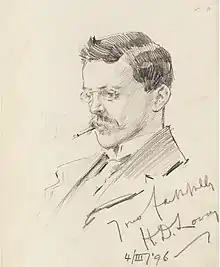Henry Dawson Lowry
Henry Dawson Lowry (22 February 1869 – 21 October 1906) was an English journalist, short story writer, novelist and poet.[1]
Henry Dawson Lowry | |
|---|---|
 Lowry, c. 1895 | |
| Born | 22 February 1869 Truro, England |
| Died | 21 October 1906 (aged 37) Herne Hill, England |
| Occupation | Journalist, short story writer, novelist, and poet |
| Alma mater | |
| Signature | |
Early life
Lowry was born at Truro, as the eldest son of Thomas Shaw Lowry, bank clerk at Truro, afterwards bank manager at Camborne, by his wife Winifred Dawson of Redhill.[2] Catherine Amy Dawson Scott was his cousin.[3] Educated at Queen's College, Taunton, and then at the University of Oxford (unattached to a particular Oxford college) with B.A. in chemistry in 1891.[4]
Writing and career
In 1891, Lowry's Cornish stories were accepted by W. E. Henley for publication in the National Observer and a number of his subsequent novels focussed on life in Cornwall. Two years later, in 1893 Lowry took up residence in London and wrote for the Pall Mall Gazette, becoming a staff member in 1895. Subsequent to this, Lowry was on the staff of Black and White from 1895 to 1897.
Early in 1897, Lowry became the editor of the Ludgate Magazine and later in the year joined the staff of the Morning Post. In his career at the Pall Mall Gazette, the Black and White, Ludgate Magazine, and the Morning Post, Lowry worked closely with James Nicol Dunn and Lowry dedicated his 1895 book Women
's Tragedies to Dunn.[5] Lowry wrote under the pseudonym "The Impenitent" for the Daily Express and occasionally contributed to other newspapers and magazines.[6]
In 1896, Lowry was the subject of a pencil drawing by Australian artist Percy Spence, now held at the National Portrait Gallery.[7]

Later life and legacy
Lowry was consistently sickly throughout his life and died at his home at Herne Hill, south London, of pneumonia on 22 October 1906 aged 37 and is buried in a graveyard in Norwood, London.[1] In 1912, Edgar Preston wrote a memoir of Lowry in A Dream of Daffodils; Last Poems by H.D. Lowry, where he described Lowry thus: 'his whole story was composed of a few small volumes of verse, some earnest friendships, one passion, and a premature death'.[1]
Lowry's cousin Catherine Amy Dawson Scott,[3] who did some editing of his poetry,[3] used text by Lowry adapting one of her own novels (The Haunting, 1921) into the libretto for the opera Gale by Ethel Leginska, which premiered in Chicago at the Civic Opera House, with John Charles Thomas in the lead, on 23 November 1935.[8]
Selected works
- Lowry, Henry Dawson (1893). Wreckers and Methodists.
- Women's Tragedies. 1895.
- A Man of Moods. 1896.
- Make Believe. 1896.
- The Happy Exile. 1897.
- The Hundred Windows. 1904; a book of poems
{{cite book}}: CS1 maint: postscript (link) - A Dream of Daffodils; Last Poems by H.D. Lowry ... Arranged for the press by G.E. Matheson & C.A. Dawson Scott. With a memoir by Edgar A. Preston. 1912.
References
- Thomas Finlayson Henderson (1912). . In Lee, Sidney (ed.). Dictionary of National Biography (2nd supplement). London: Smith, Elder & Co.
- Henderson, Thomas Finlayson. "Lowry Henry Dawson". Retrieved 29 October 2016 – via Wikisource.
- "Charlotte Mew Chronology with mental, historical and geographical connections linking with her own words, and listing her essays, stories, poems and friends". Retrieved 29 October 2016.
- Sutherland, John. 2008. The Longman companion to Victorian fiction. Harlow: Longman. p. 389
- Lowry, Henry Dawson (1895). Women's Tragedies. John Lane. Retrieved 11 November 2020.
- "Lowry, Henry Dawson". Who's Who. 1906. p. 1048.
- "Henry Dawson Lowry - National Portrait Gallery". www.npg.org.uk. Retrieved 20 April 2022.
- Margaret Ross Griffel (21 December 2012). Operas in English: A Dictionary. Scarecrow Press. p. 230. ISBN 978-0-8108-8325-3.